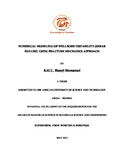| dc.contributor.author | Kalu, Ifeanyi Emmanuel | |
| dc.date.accessioned | 2016-06-13T14:27:57Z | |
| dc.date.available | 2016-06-13T14:27:57Z | |
| dc.date.issued | 2013-05-12 | |
| dc.identifier.uri | http://repository.aust.edu.ng/xmlui/handle/123456789/421 | |
| dc.identifier.uri | http://library.aust.edu.ng:8080/xmlui/handle/123456789/421 | |
| dc.description.abstract | Wellbore instabilities are responsible for 10-20% of the total drilling cost. It has been estimated that wellbore instability causes an annual economic loss of US$ 500 - 1000 million in the oil industry across the world. Hence, the maintenance of wellbore stability is of major concern to drilling engineers in the oil and gas industry. Hence, several models have been developed for the assessment or prediction of wellbore instabilities. However, these models do have some limitations. They often require the use of mechanical property data that is relatively difficult to generate in the field, as most rely on mechanical property measurements typically obtained from core samples that are costly to extract. Most of the existing models require parameters that can only be obtained through complicated and difficult laboratory testing. Even when the data is available, the often exhaustive list of input data required by the models may be difficult to relate to wellbore stability. Furthermore, the conventional strength based models neglects the existence of pre-existing cracks in the rock formations which can remarkably affect the stability of well bores when subjected to various stresses. There is, therefore, a need to develop new approaches that are easier to implement. The models must also address limitations of the existing models and serve as a guide for the assessment or prediction of well bore instability.
This study presents a numerical modeling of wellbore instability (shear failure) using fracture mechanics approach. A typical well bore consists of various layers of rock formations having inherent cracks and distinct mechanical properties. Using the concept of linear elastic fracture mechanics (LEFM), the wall of a distinct layer of the wellbore containing cracks of various sizes (ranging from 0.5” to 2.5”) inclined at a particular angle and subjected to a range of bottom hole pressure (3000 – 7000 psi) was numerically modeled using the ABAQUS software package. The insights from these models were used to guide the prediction of the onset of shear failure wellbore instability and consequently the determination of the lower bound mud weight window for safe drilling operations in conventional wells. | en_US |
| dc.language.iso | en | en_US |
| dc.subject | Kalu Ifeanyi Emmanuel | en_US |
| dc.subject | Prof Wole Soboyejo | en_US |
| dc.subject | 2013 Materials Science and Engineering | en_US |
| dc.subject | Wellbore Instability (SHEAR Failure) | en_US |
| dc.subject | Fracture Mechanics | en_US |
| dc.subject | Numerical Modeling of Wellbore Instability | en_US |
| dc.title | Numerical Modeling of Wellbore Instability (SHEAR Failure) using Fracture Mechanics Approach | en_US |
| dc.type | Thesis | en_US |

